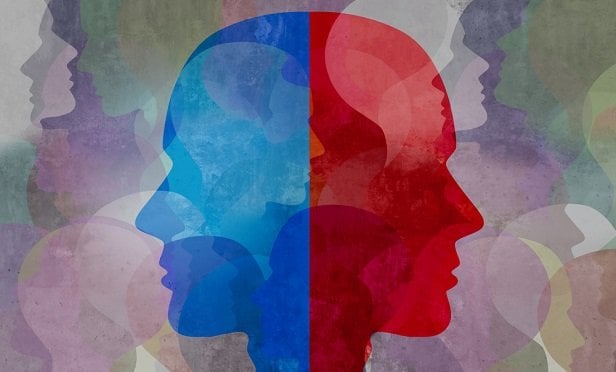 Mental health impacts employeeengagement, productivity, turnover and other variables every bit asmuch as physical well-being–depression alone leads to over 200million lost workdays a year. (Photo: Shutterstock)
Mental health impacts employeeengagement, productivity, turnover and other variables every bit asmuch as physical well-being–depression alone leads to over 200million lost workdays a year. (Photo: Shutterstock)
When was the last time one of your employees took time off from work by calling in“sad”?
|While it's common for people not to work when they have a cold, break a bone or suffer from anynumber of physical ailments, the same is not true when it comes tomental health. In many workplaces, discussingmental wellness is taboo — despite research that shows that 1 in 5 peopleexperience mental illness. Plus, there's my own unofficial researchshowing that 5 in 5 people experience broader emotional challenges at times that can hinderwork.
|Often, a company's strategy to address mental health consists ofdirecting people to a wellness app and an employee assistance program (EAP)hotline, maybe a meditation class during lunch.It's rarely something openly discussed.
|Related: Let's get real about mental health in theworkplace
|But mental-on-mobile health, an 800 number, and downward facingdog may not be an effective strategy. While they can certainly beuseful tools as part of larger efforts to tackle mental health,they typically fail to make meaningful impact over the longhaul.
|Of course, no one will publicly state that mental well-beingisn't important, or even less important than its physicalcounterpart. That's because deep down, none of us has to be apsychologist to recognize that mental well-being matters. In otherwords, it's not that organizations don't value the mental health oftheir people. They just don't know how to influence it.
|So, the stigma persists. An employee who openly talks aboutone's emotional challenges — particularly an illness — risks beingviewed as that employee. You know, the troubled one. The weird one.The unreliable one. The crazy one.
|But you know what's really crazy? Acting as if mental healthdoesn't impact employee engagement, productivity, turnover andother variables every bit as much as physical well-being. Indeed,the CDC estimates that depression alone leads to over 200 million lost workdays a year.
|Except, few people are actually calling in “sad.” They make upexcuses. They lie about what is really going on with them. As aresult, mental issues become inherently less visible than theirphysical counterparts, which means addressing them becomes thatmuch harder.
|And that much more important. To truly tackle the mentalwell-being of your people, it's important to stop outsourcingresponsibility to technology and hotlines and start acknowledgingthat this is predominantly a culture issue.
|What can leaders do?
Leaders who have faced or are experiencing their own mentalstruggles should consider candidly discussing them with theiremployees. Obviously, a lot depends on individual comfort level,but executives who open up about their personal lives showvulnerability and build empathy in ways that can destigmatizemental health issues.
|For example, after the death of her husband, Facebook COO SherylSandberg went through a time of intense grief and depression. Byeventually speaking and writing about it, she showed that —surprise! — she's human just like you and me. Equally importantly,she helped elevate discussion around grief to help generate a morehumane bereavement policy at Facebook.
|Leaders who serve as such role models can also bring to lifecorporate values that were otherwise merely words written in anemployee handbook tucked away in a remote corner of your intranet.For example, a top leader revealing personal mental challengesdemonstrates values built around trust and caring.
|What can managers do?
Senior leaders may set the tone at the top, but it's up tomanagers to operationalize it by making their direct reports feelcomfortable discussing mental health. Here, again, it's not thatmanagers don't care about their people (well, some probably don't).It's that discussing something outside of Excel sheets and theweather discomforts managers. Or, they worry, it discomforts theiremployees. Or they just don't want to pry. Or they fear potentiallegal repercussions should an employee later claim unfair treatmentbecause they divulged personal-health details.
|However, a manager's central responsibility is to support directreports. You can't do that effectively if you don't invest indeveloping relationships built around more than just work projectsand due dates. Managers should establish connections built onmutual trust by appreciating that every individual is not just aworker but a person.
|In addition to managers talking more candidly about their ownpersonal struggles, they should look for indicators that might showan employee is suffering on the inside. Such signs include:
- Changes in behavior, like becoming more aggressive orwithdrawn
- Increasing use of sick days and absences
- Fatigue and exhaustion
- Decreased confidence
- Disinterest in work
The more that managers pay attention to what might be cries forhelp, the better they'll be able to address them withnonjudgmental, caring, and empathetic conversations.
|What can all of us do?
When a coworker seems “off,” it's OK to ask how that person isdoing. Except, not with the standard flippant, “Hi, how are you?”We all know that's not a question so much as a greeting with anexpected answer, “Good, how about you?”
|“Good.”
|But are we good? The next time someone asks you how you'refeeling, surprise the other person with the truth if you're notfeeling well. Give your coworkers the opportunity to help you. (Ofcourse, respect boundaries if someone is uncomfortable discussingpersonal details.)
|Ultimately, it's on all of us to make mental health a morecomfortable subject to discuss. As writer and speaker Abby Mosconisuggests in her DisruptHR presentation, “Talk about going totherapy with the same casualness you would talk about going to thegym. Oh Cheryl, I would love to go to lunch with you, but I can't.I have a date with my therapist.”
|Having such candid conversations might feel awkward at first —but such discomfort is often an inherent part of cultural change.Eventually, though, being open to talking about mental health willstrengthen the relationships we have with our colleagues. Putotherwise, addressing mental health is not just a challenge — it'san opportunity to enable people to relate to and understand eachother in ways that will create a better workplace. And healthierpeople deliver healthier results.
Read more:
- Mental health is a product of totalhealth
- 4 ways to foster employees' mental health in theworkplace
- Coming soon: Onsite behavioral healthclinics
Dan Neuburger is the Chief ExecutiveOfficer at Viventium, a purely cloud-based Payroll and HR(HCM) software company that provides a user experience and designanyone can use with ease, unbeatable analytics, and insight intoyour business.
Complete your profile to continue reading and get FREE access to BenefitsPRO, part of your ALM digital membership.
Your access to unlimited BenefitsPRO content isn’t changing.
Once you are an ALM digital member, you’ll receive:
- Critical BenefitsPRO information including cutting edge post-reform success strategies, access to educational webcasts and videos, resources from industry leaders, and informative Newsletters.
- Exclusive discounts on ALM, BenefitsPRO magazine and BenefitsPRO.com events
- Access to other award-winning ALM websites including ThinkAdvisor.com and Law.com
Already have an account? Sign In







